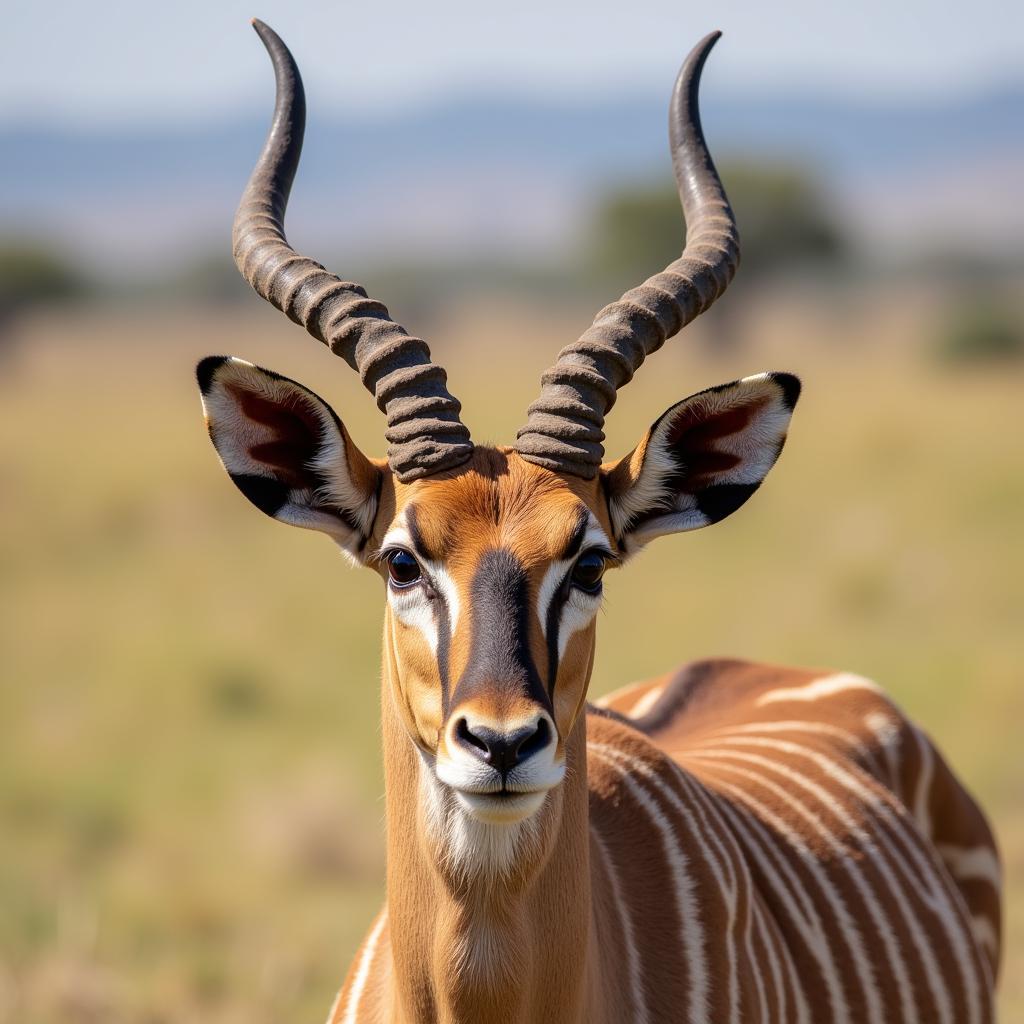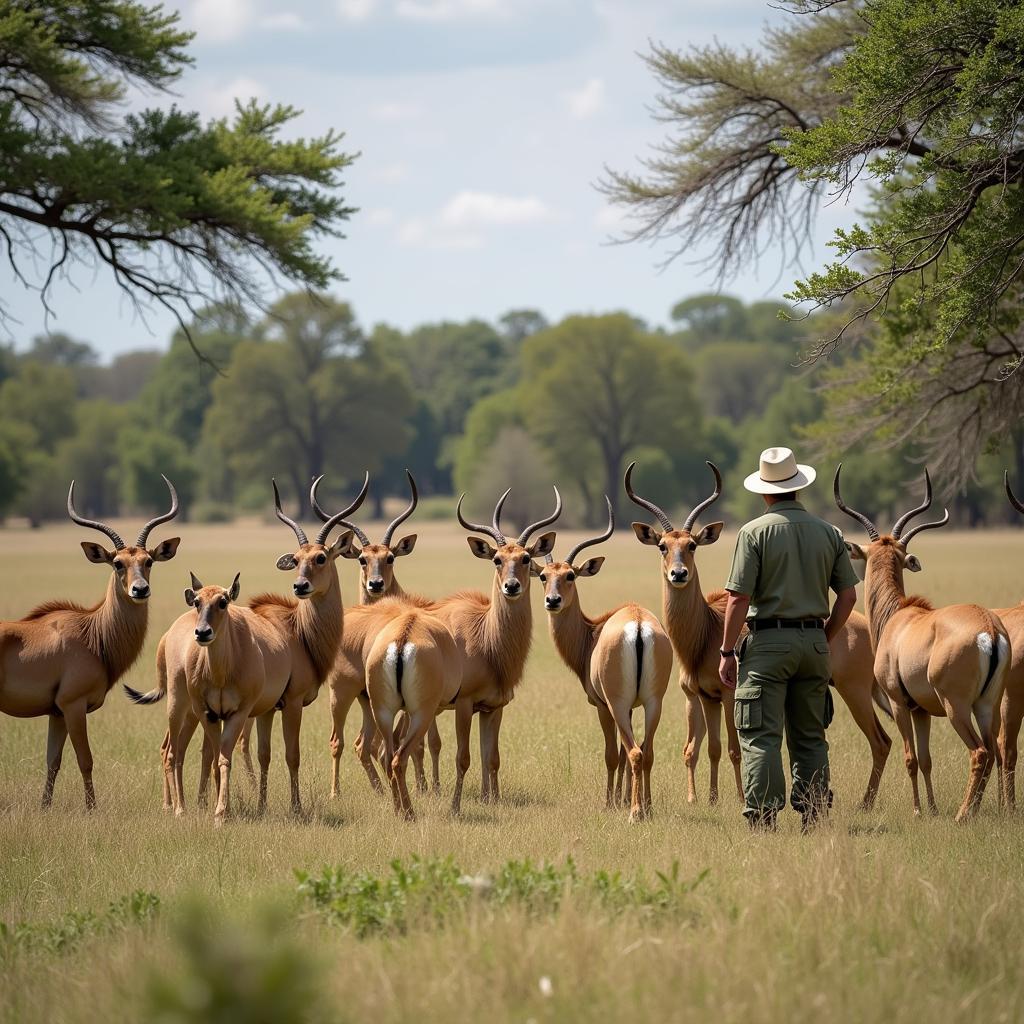Unveiling the Eland: A Large African Antelope
The eland, a large African antelope often mistaken for cattle, roams the vast savannas and woodlands of sub-Saharan Africa. This majestic creature, scientifically known as Taurotragus oryx, captivates with its spiral horns, distinctive markings, and imposing size. Let’s delve into the fascinating world of the eland, exploring its unique characteristics, habitat, behavior, and cultural significance.
The Eland: Physical Characteristics and Adaptations
The eland is the largest antelope species, with bulls weighing up to 2,000 pounds and standing nearly six feet tall at the shoulder. Their most striking feature is their tightly spiraled horns, present in both males and females. These horns can reach lengths of up to 40 inches in males and are used for defense and establishing dominance within the herd. Elands also have a dewlap, a loose fold of skin hanging from the neck, which is more pronounced in males. Their coat color varies from reddish-brown to gray, often with vertical white stripes along their flanks. These stripes provide camouflage in the dappled light of the woodlands and savannas.
 Eland Antelope Physical Traits
Eland Antelope Physical Traits
Habitat and Distribution of the Large African Antelope
Elands are adaptable animals, inhabiting a variety of environments across sub-Saharan Africa. They are found in savannas, grasslands, woodlands, and even mountainous regions. Their ability to thrive in these diverse habitats is attributed to their tolerance of drought conditions and their ability to browse on a wide range of vegetation. Elands can survive for extended periods without water, obtaining moisture from the plants they consume. Their distribution extends from Senegal in West Africa to Ethiopia in East Africa and down to South Africa.
Social Behavior and Diet of the Eland Antelope
Elands are social animals, forming herds that can range in size from a few individuals to several hundred. These herds are typically composed of females and their young, led by a dominant female. Males may form bachelor herds or live solitary lives, joining female herds during the breeding season. Elands are primarily grazers, feeding on grasses, leaves, and fruits. They are also known to dig for roots and tubers during dry periods. Their diverse diet contributes to their adaptability and ability to survive in various habitats.
What do Elands eat?
Elands are herbivores with a diverse diet, consuming grasses, leaves, fruits, roots, and tubers.
The Cultural Significance of the Eland
The eland holds significant cultural value for many African communities. It is often depicted in rock art and folklore, symbolizing strength, grace, and abundance. In some cultures, the eland is considered a sacred animal and plays a crucial role in traditional ceremonies and rituals. Its meat and hide are also valued resources, providing sustenance and materials for clothing and shelter.
Is the eland important to African cultures?
Yes, the eland is often seen as a symbol of strength and abundance in many African cultures.
Conservation Status of the Large African Antelope
While elands are not currently considered endangered, their populations have declined in some areas due to habitat loss, hunting, and competition with livestock. Conservation efforts are crucial to ensure the long-term survival of this magnificent creature. These efforts include protecting their natural habitats, regulating hunting practices, and promoting sustainable land management strategies.
 Eland Antelope Conservation Status
Eland Antelope Conservation Status
Conclusion: The Majestic Eland of Africa
The eland, a large African antelope, stands as a testament to the diversity and resilience of African wildlife. From its imposing size and spiraled horns to its adaptability and cultural significance, the eland captivates and inspires. Protecting this magnificent creature and its habitat is essential for preserving the rich biodiversity of Africa for generations to come.
FAQs about the Large African Antelope
- What is the largest antelope in Africa? The eland.
- What are the distinctive features of the eland? Spiral horns, dewlap, and vertical stripes.
- Where do elands live? Sub-Saharan Africa, in various habitats like savannas and woodlands.
- What do elands eat? Grasses, leaves, fruits, roots, and tubers.
- Are elands endangered? Not currently, but their populations are declining in some areas.
- What is the cultural significance of the eland? It symbolizes strength, grace, and abundance in many African cultures.
- What are the main threats to eland populations? Habitat loss, hunting, and competition with livestock.
For further assistance, please contact us at Phone Number: +255768904061, Email: kaka.mag@gmail.com Or visit our office at Mbarali DC Mawindi, Kangaga, Tanzania. We have a 24/7 customer service team.
